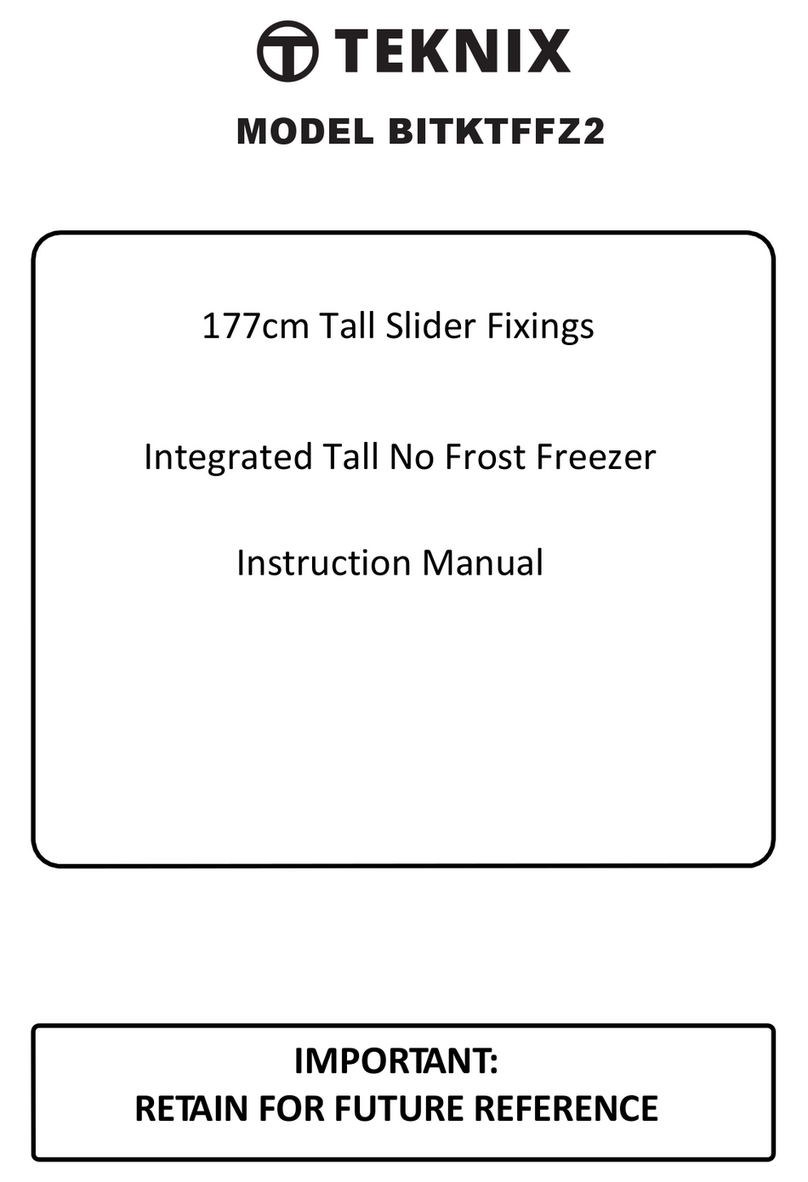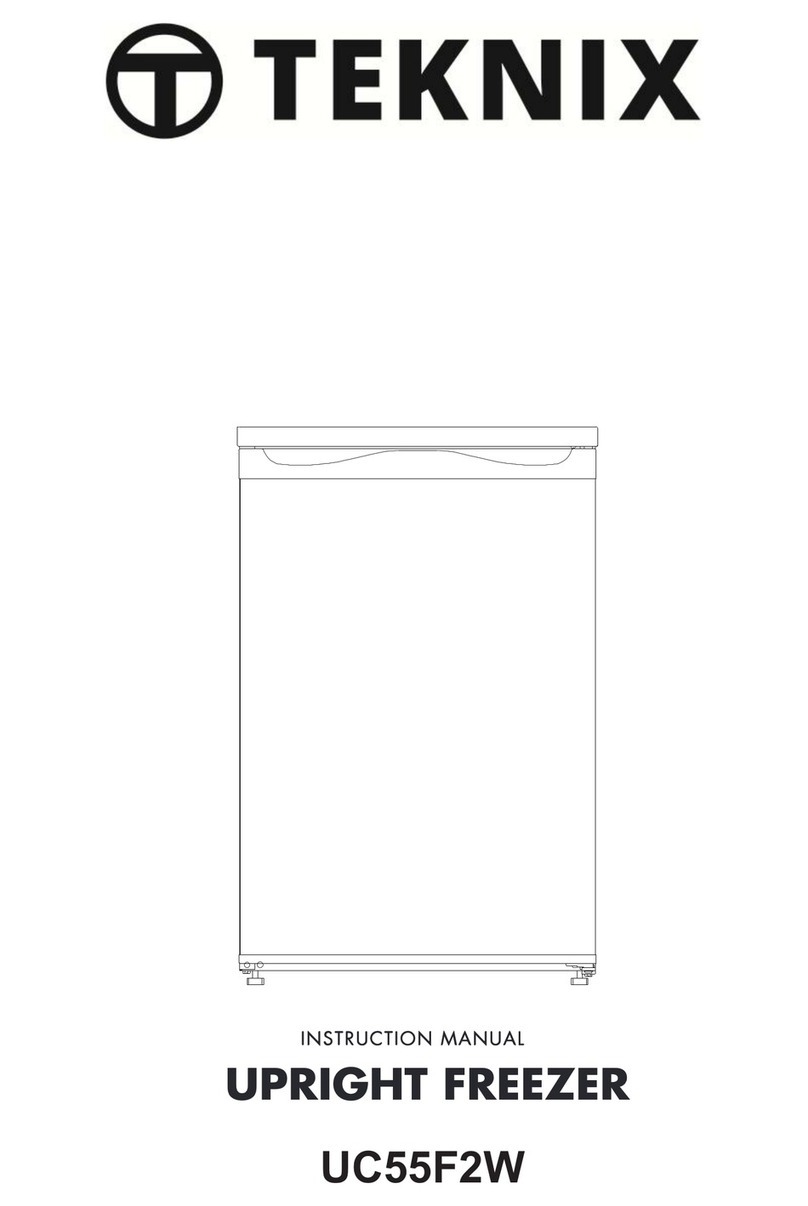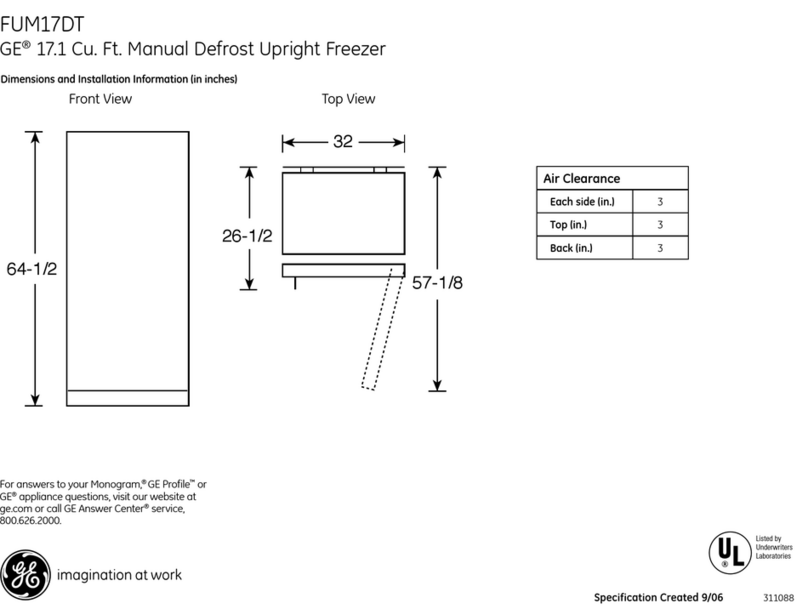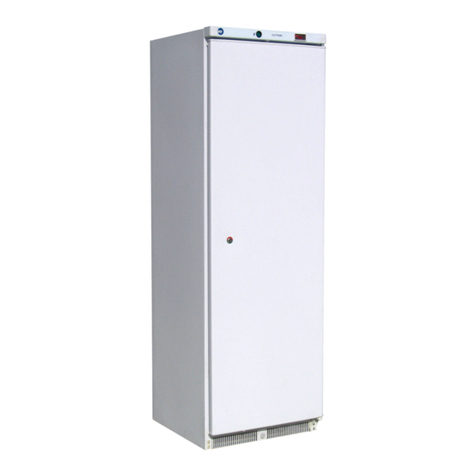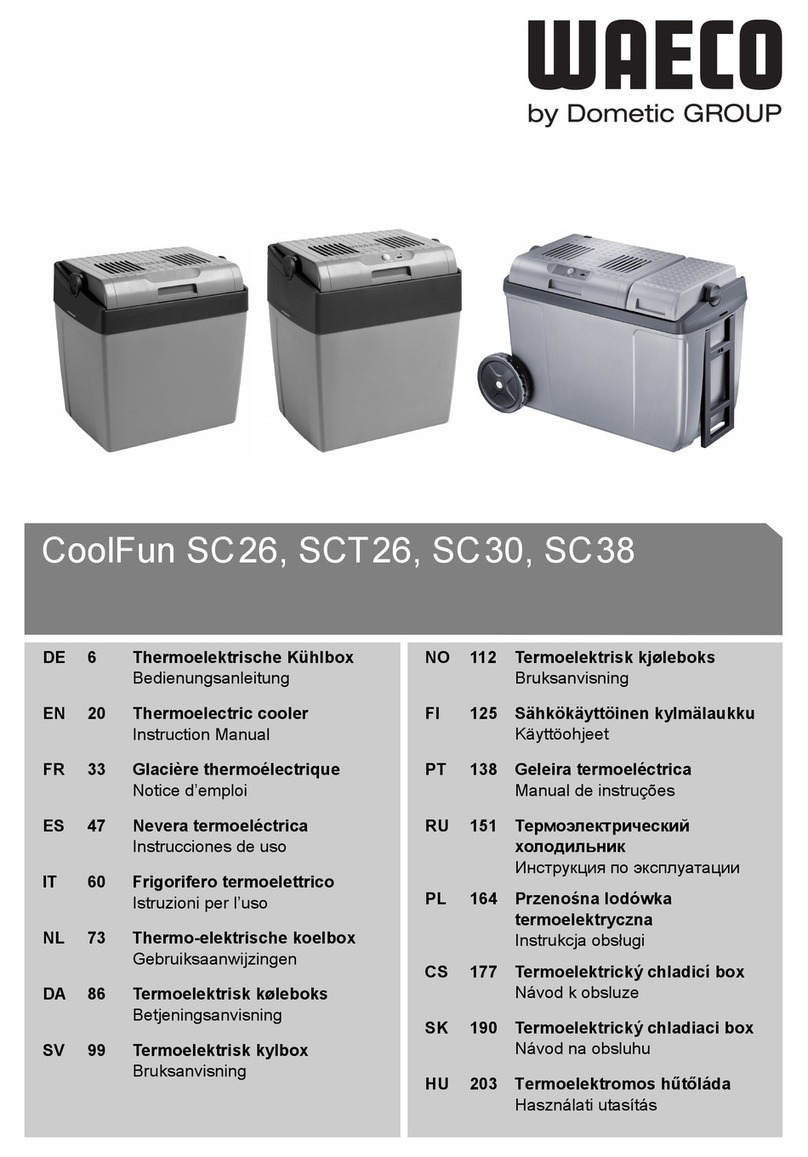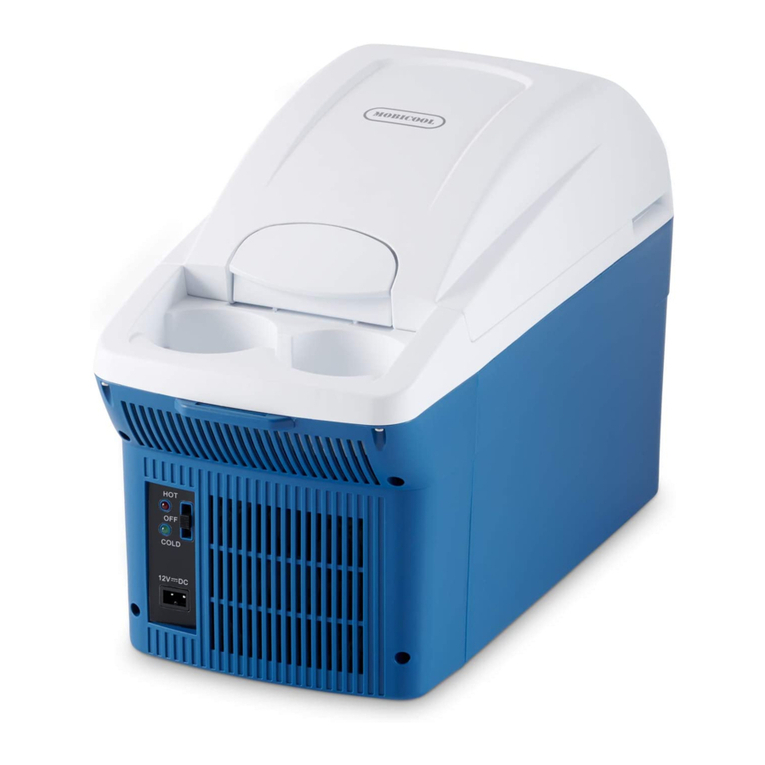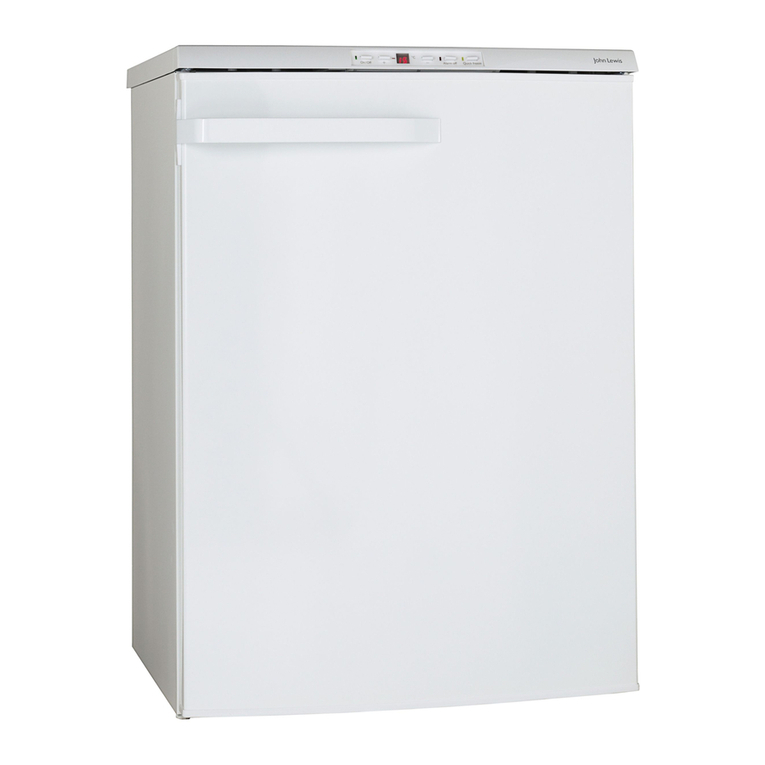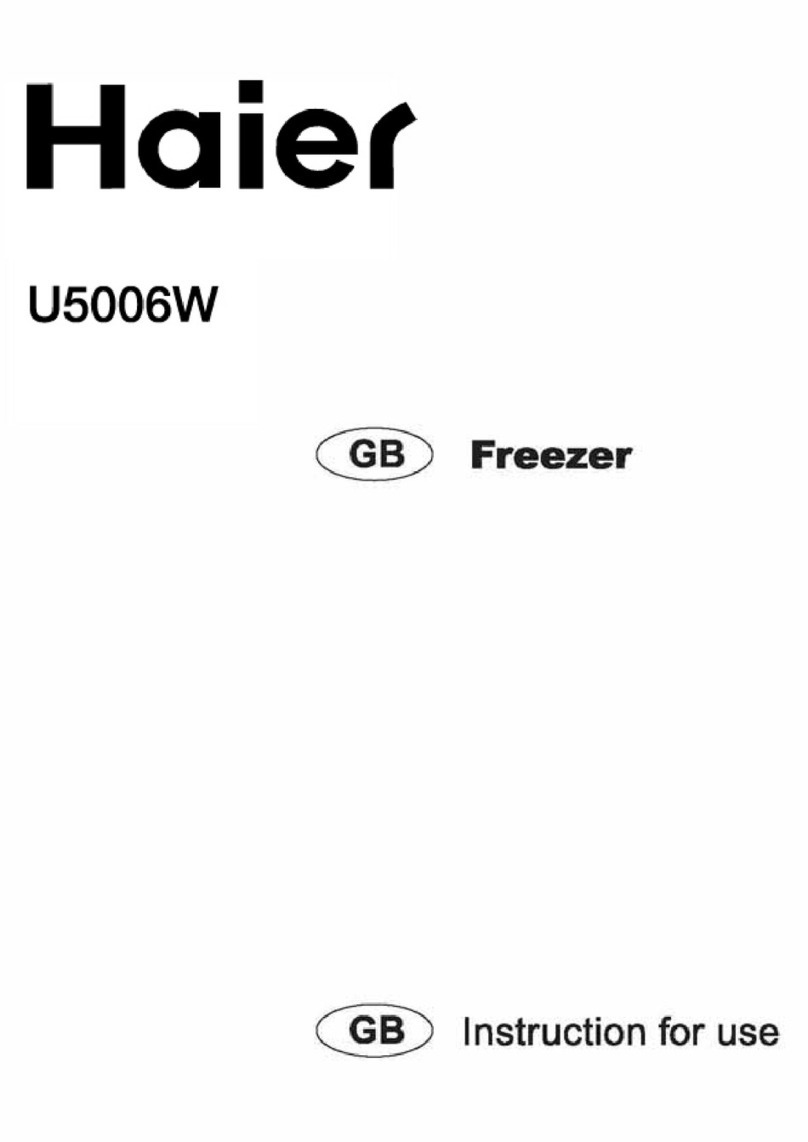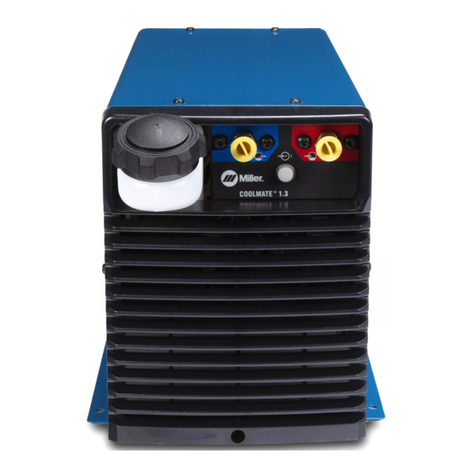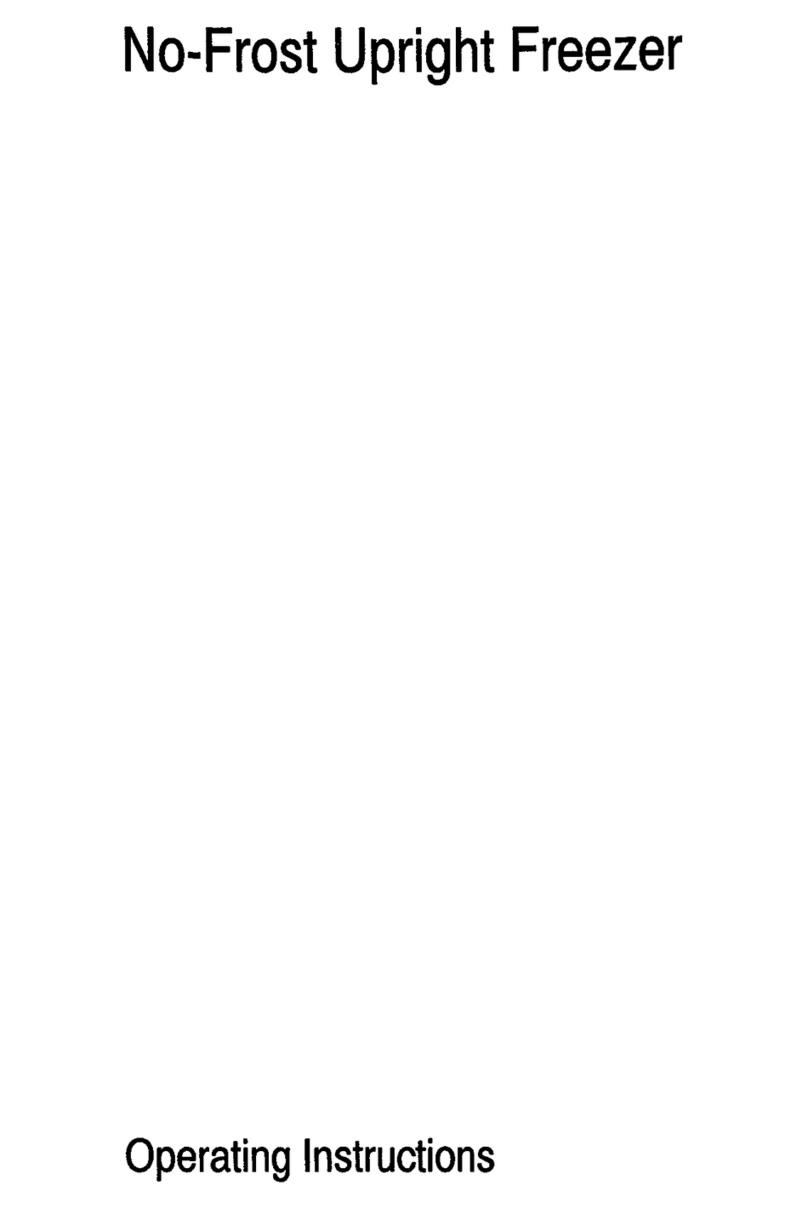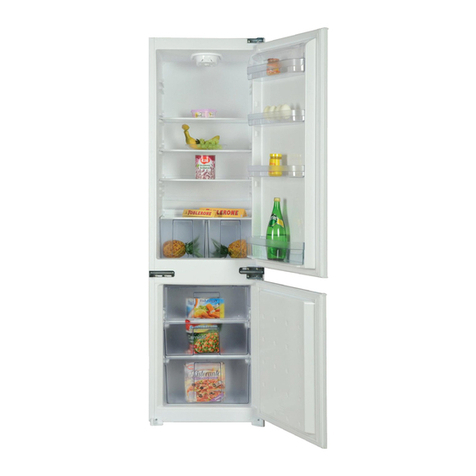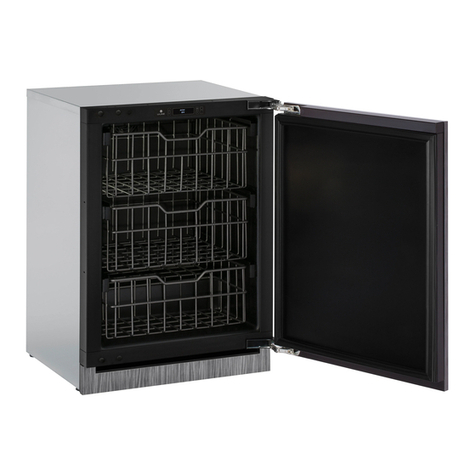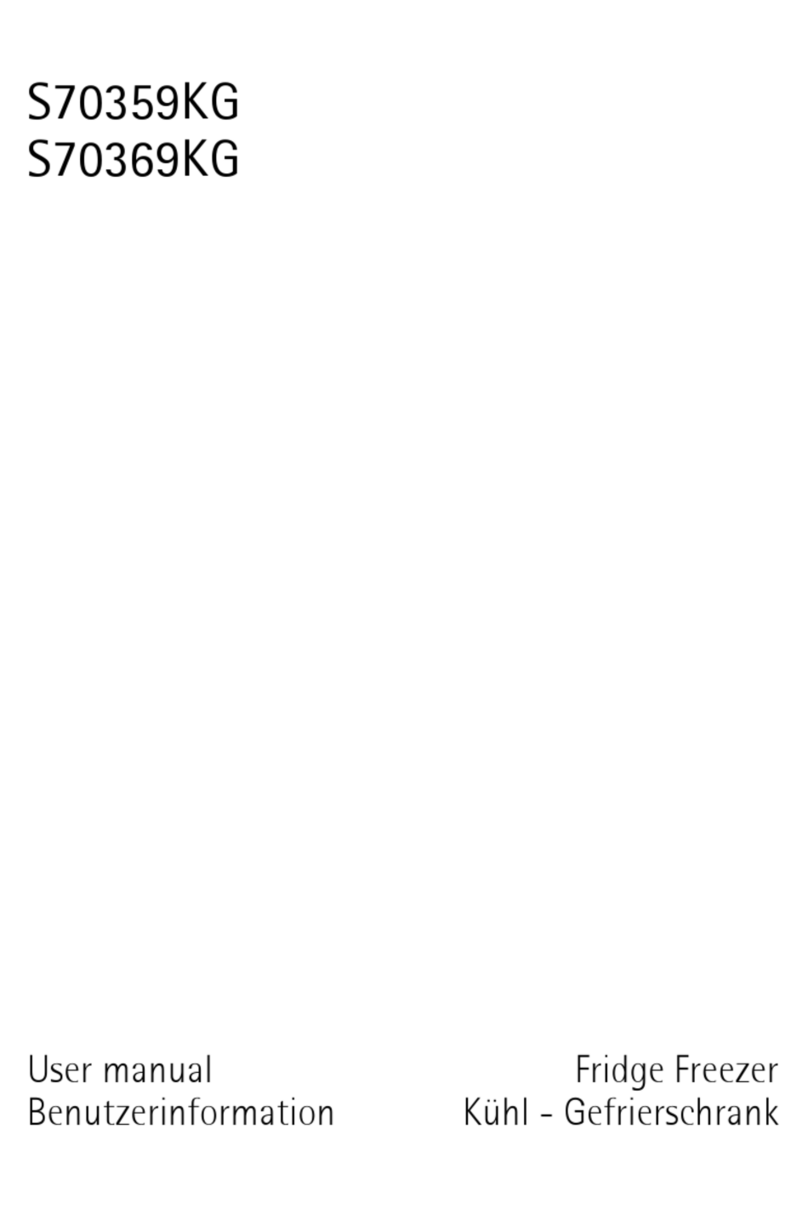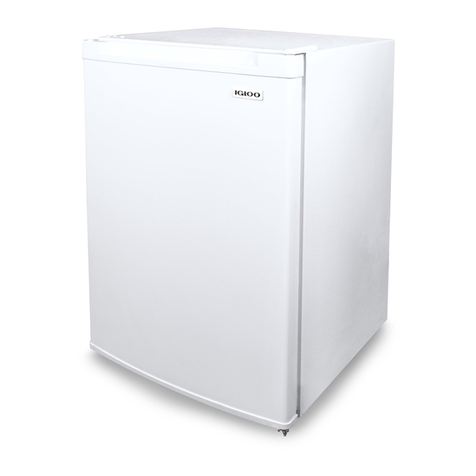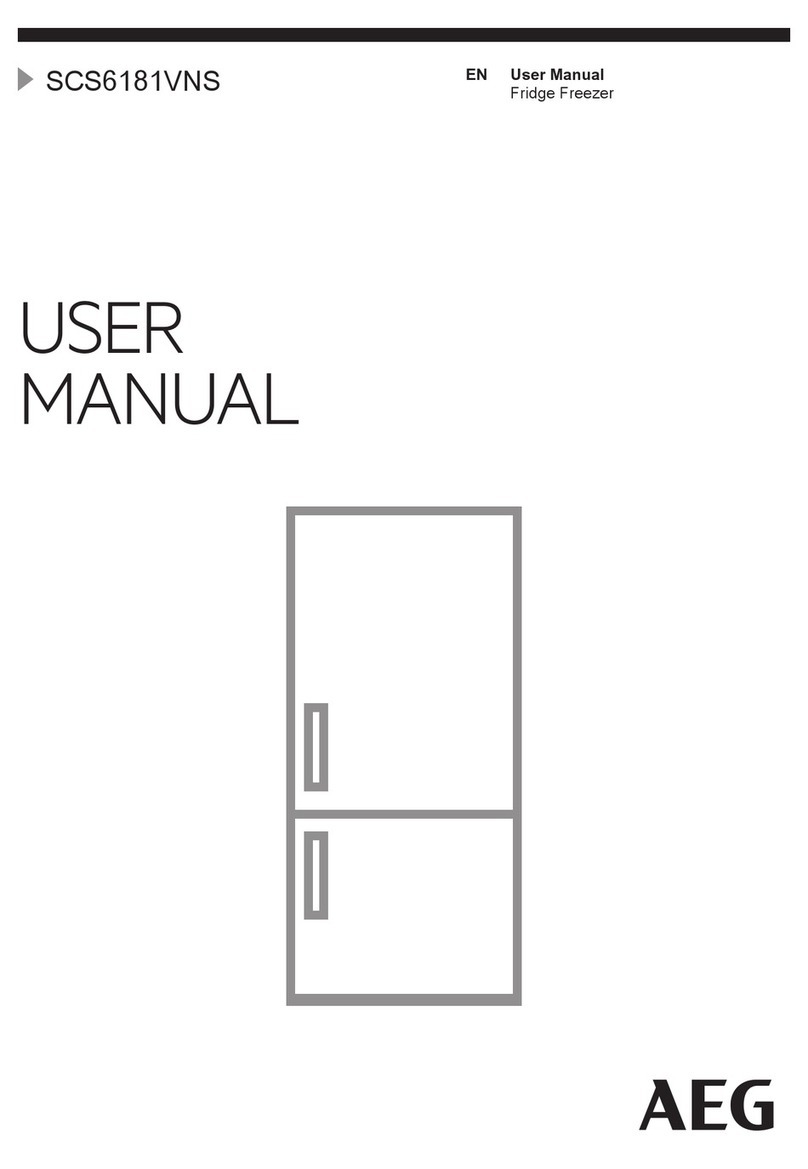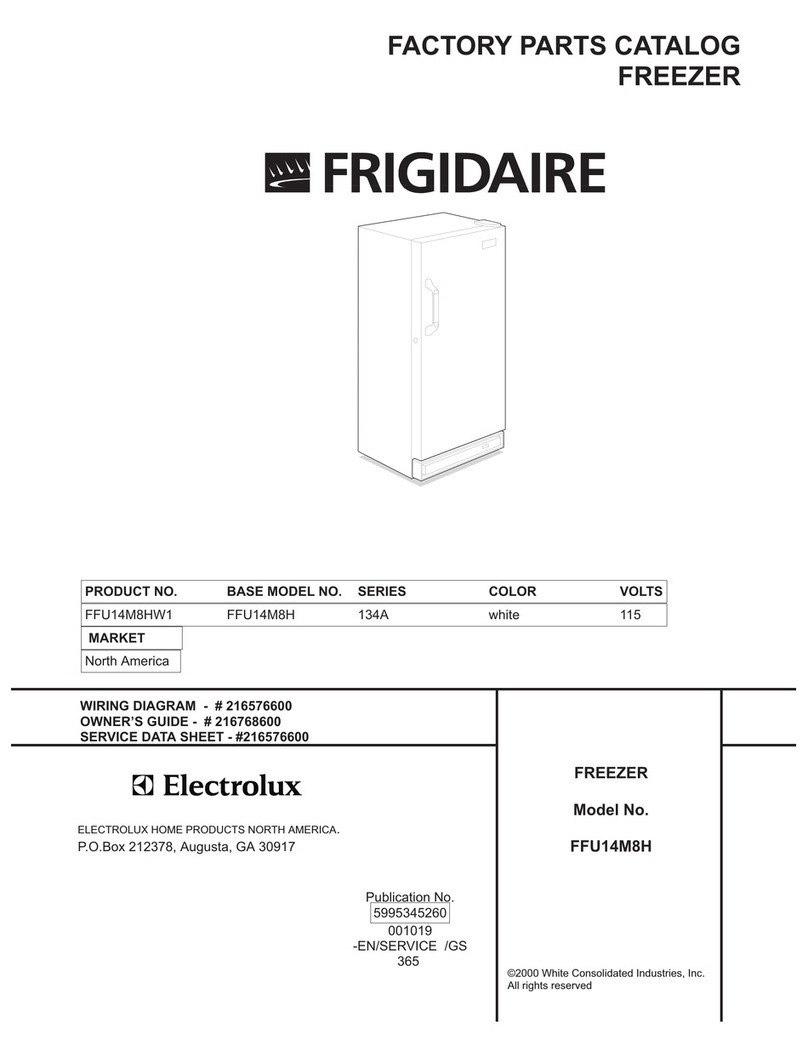TEKNIX T55F2W User manual

T55F2W

4
If you require any technical guidance or nd that the product is not operating as intended, please see the Troubleshooting section of this manual
I. SAFETY INSTRUCTIONS
WARNING: It is hazardous for anyone other than authorised service personnel to
carry out servicing or repairs which involves the removal of covers. To avoid the
risk of an electric shock, do not attempt to repair this appliance yourself.
WARNING: Risk of re / ammable materials.
Safety Warnings and Information
WARNING: Do not use electrical appliances such as a hair dryer or heater to defrost your
Freezer.
WARNING: Containers with ammable gases or liquids can leak at low temperatures.
WARNING: Do not store any containers with ammable materials, such as spray cans, re
extinguisher, rell cartridges etc. in the Freezer.
WARNING: Do not place carbonated or zzy drinks in the Freezer compartment. Ice lollies
can cause “Frost/Freeze burns” if consumed straight from the Freezer.
WARNING: Do not remove items from the Freezer compartment if your hands are damp/wet,
as this could cause skin abrasions or “Frost/Freezer burns”. Bottles and cans must not be
placed in the Freezer compartment as they can burst when the contents freeze.
WARNING: Manufacturer’s recommended storage times should be adhered to. Refer to
relevant instructions.
WARNING: Do not allow children to tamper with the controls or play with the appliance.
IMPORTANT: The appliance is heavy. Care should be taken when moving it. It is dangerous
to alter the specication or attempt to modify this product in any way.
WARNING: Do not store ammable gases or liquids inside your Freezer.
IMPORTANT: If the power cable is damaged, it must be replaced by the manufacturer, its
service agent or similarly qualied persons in order to avoid a hazard.
WARNING: This appliance can be used by children aged from 8 years and above and
persons with reduced physical, sensory or mental capabilities or lack of experience and
knowledge, if they have been given supervision or instruction concerning use of the
appliance in a safe way and understand the hazards involved. Children shall not play
with the appliance. Cleaning and user maintenance shall not be made by children without
supervision.
IMPORTANT: This appliance is intended to be used in household and similar applications
such as
– staff kitchen areas in shops, ofces and other working environments,
– farm houses and by clients in hotels, motels and other residential type environments,
– bed and breakfast type environments,
– catering and similar non-retail applications.
• Keep ventilation openings, in the appliance enclosure or in the built-in structure, clear of
obstruction.
• Do not use mechanical devices or other means to accelerate the defrosting process, other
than those recommended by the manufacturer.
• Do not damage the refrigerant circuit.
• Do not use electrical appliances inside the food storage compartments of the appliance,

5
unless they are recommended by the manufacturer.
• Do not store explosive substances such as aerosol cans with a ammable propellant in
this appliance.
• This appliance is not intended for use by persons (including children) with reduced
physical, sensory or mental capabilities, or lack of experience and knowledge, unless
they have been given supervision or instruction concerning use of the appliance by a
person responsible for their safety. Children should be supervised to ensure that they do
not play with the appliance.
IMPORTANT: Keep ventilation openings in the appliance enclosure or in the built-in structure,
clear of obstruction.
WARNING: Do not use mechanical devices or other means to accelerate the defrosting
process, other than those recommended by the manufacturer.
WARNING: Do not damage the refrigerant circuit.
WARNING: Do not use electrical appliances inside the food storage compartments of the
appliance, unless they are of the type recommended by the manufacturer.
WARNING: Refrigerating appliances, in particular a refrigerator-freezer, might not operate
consistently (possibility of defrosting of contents or temperature becoming too warm in the
frozen food compartment), when appliance is running for an extended period of time, below
the cold end of the range of temperatures for which the refrigerating appliance is designed.
WARNING: It is necessary that, for doors or lids tted with locks and keys, the keys be kept
out of the reach of children and not in the vicinity of the refrigerating appliance, in order to
prevent children from being locked inside.
WARNING: The refrigerant used in your appliance and insulation materials requires special
disposal procedures.
WARNING: When positioning the appliance, ensure the supply cord is not trapped or
damaged.
WARNING: Do not locate multiple portable socket-outlets or portable power supplies at the
rear of the appliance
Children aged from 3 to 8 years are allowed to load and unload refrigerating appliances.
To avoid contamination of food, please adhere to the following instructions:
• Opening the door for long periods can cause a signicant increase of the temperature in
the compartments of the appliance.
• Clean regularly surfaces that can come in contact with food and have accessible
drainage systems.
• Clean water tanks if they have not been used for 48 hours, ush the water system
connected to a water supply if water has not been used for 5 days.
• Store raw meat and sh in suitable containers in the refrigerator, so that it is not in contact
with or drip onto other food.
• Two-star frozen food compartments are suitable for storing pre-frozen food, storing or
making ice-cream and making ice cubes.
• One, two and three-star compartments are not suitable for the freezing of fresh food.
• If the refrigerating appliance is left empty for long periods of time, switch off, defrost,
clean, dry, and leave the door open to prevent mould developing within the appliance.

6
If you require any technical guidance or nd that the product is not operating as intended, please see the Troubleshooting section of this manual
Electrical Supply Connection
• Connect the appliance to the electrical supply (220-240 V ~ 50 Hz) with the plug and
lead, which are tted.
• Connections to the mains supply should be in accordance with local regulations.
• DO NOT use plug adapter.
• The appliance must be plugged into an earthed socket
• Always make sure that the plug is accessible after the appliance has been positioned.
• If the electrical cable is damaged or worn, turn off the refrigerator and consult an
authorised agent for replacement.
Electrical Safety
WARNING: When positioning the appliance, ensure the supply cord is not
trapped or damaged.
WARNING: DO NOT locate multiple portable socket- outlets or portable power
supplies at the rear of the appliance
DO NOT use plug adapter.
WARNING: Risk of re / ammable materials
• The plug must be accessible after installation.
• The operating voltage for your appliance is 220-240 V at 50Hz.
• Connections to the mains supply should be in accordance with local regulations.
• Insert the plug into a socket with an efcient ground connection. If the socket has no
ground contact or the plug does not match, we recommend you consult a qualied
electrician for assistance.
• The appliance must be connected with a properly installed fused socket. The power
supply (AC) and voltage at the operating point must match with the details on the name
plate of the appliance (the name plate is located on the inside left of the appliance).
• The appliance must be plugged into an earthed socket.
• The plug MUST be accessible after the appliance has been positioned. The cord should
be secured and not left exposed or dangling to prevent accidental injury.
• The appliance is supplied with a standard three-pin plug, of which the one for grounding
should never be removed.
• Hold the plug, not the electrical cable, when unplugging the appliance.
• Make sure that the appliance does not trap the electric cable.
• DO NOT step on the cable.
• Avoid damage to the electric cable when moving the appliance.
• This refrigerator appliance is not designed to be used with an inverter.
DO NOT use an extension cord with this appliance. If the power cord is too short, have
a qualied electrician or service technician install an outlet near the appliance. Use of an
extension cord can negatively affect the performance of the unit.
WARNING: Improper use of the grounded plug can result in the risk of electrical shock. If the
power cord is damaged, have it replaced by an authorised service provider.

7
Climate Range
The information about the climate range of the appliance is provided on the rated plate. It
indicates at which ambient temperature (that is, the room temperature in which the appliance
is working) the operation of the appliance is optimal (proper).
Climate range Permissible ambient temperature
SN from +10°C to +32°C
N from +16°C to +32°C
ST from +16°C to +38°C
T from +16°C to +43°C
Note: Given the limit values of the ambient temperature range for the climate classes for which the refrigerating
appliance is designed, and the fact that the internal temperatures could be affected by such factors as location
of the refrigerating appliance, ambient temperature and the frequency of door opening, the setting of any
temperature control device might have to be varied to allow for these factors, if appropriate.
Freon-free
The freon-free refrigerant (R600a) and the foaming insulation material (cyclopentane) are
used for this refrigerator and are environmentally friendly, causing no damage to the ozone
layer and having very small impact on global warming. R600a is ammable, and sealed in
a refrigeration system, without leakage during normal use. In the case of refrigerant leakage
due to the refrigerant circuit being damaged, be sure to keep the appliance away from open
ames and open the windows for ventilation as quickly as possible.

8
If you require any technical guidance or nd that the product is not operating as intended, please see the Troubleshooting section of this manual
II. Introduction
Upright Freezer Diagram
Note: Due to technological innovation, the product descriptions in this manual may not
be completely consistent with your refrigerator. Details are in accordance with the real
product.

9

10
If you require any technical guidance or nd that the product is not operating as intended, please see the Troubleshooting section of this manual
III. Preparations for use
Installation location:
1. Ventilation condition
When installing your freezer ensure it is in a well ventilated location. Do not install the
freezer near any heat source such as a cooker. Avoid locating the freezer in direct
sunlight, this will ensure you reduce the energy consumption of the appliance. Do not
locate the freezer in a damp place, this will prevent the freezer from rusting and leaking
electricity. The result of the total space of the room in which the freezer is installed being
divided by the freezer charge amount of the freezer shall not be less than 8 g/ M3. Note:
The amount of refrigerant charged for the freezer can be found on the nameplate.
2. Heat dissipation space
When your freezer is installed and running, it will give off heat to it’s surroundings.
Therefore, a minimum of 300mm free space should be at the top of the unit, minimum of
100mm on both sides, and a minimum of 50mm at the back of the refrigerator.
Dimensions in mm:
W D H A B C(°) E F
1428 566 1011 1107 125 50 100
Note: Figure 1, Figure 2 only illustrate the space demand of the product.
545

11
3. Level ground
Place the freezer on a solid and flat ground (floor) to keep it stable, or else it will give
rise to vibration and noise.
Unobstructed ventilation shall be maintained around the appliance or in an
embedded structure.
Preparations for use
1. Standing time
After the larder is properly installed and well cleaned, do not switch it on immediately.
Make sure you allow a minimum of 4 hours before turning on the power of the freezer.
2. Cleaning
Before use ensure you cleans the internal compartments and all shelves and accessories
with a soft cloth.
3. Power-on
Insert the plug into the power socket to start the compressor. After 1 hour, open the
freezer door, if the temperature inside the larder compartment drops obviously, it
indicates the refrigeration system is working normally.
4. Storage of food
After the freezer runs for a period of time, the internal temperature of the freezer will be
automatically controlled according to the user’s temperature setting. Before storing foods
in your Freezer, turn the Freezer on and wait for 24 hours, to make sure it is working
properly and to allow the Freezer to reach the correct temperature
(Try to open the freezer door as less as possible before the internal temperature cools
down).
If the freezer is installed in a moisture filled room, make sure to check whether the ground
wire and leakage circuit breaker are normal. If vibration noises are produced due to the
freezer making contact with the wall, or if the wall gets blackened by air convection around
the compressor, move the larder away from the wall. Setting up the larder may cause
jamming noise or image chaos to mobile phones, fixed-line telephone, radio receiver,
television sets surrounding it, so try to keep the refrigerator as far away as possible from
these items.

12
If you require any technical guidance or nd that the product is not operating as intended, please see the Troubleshooting section of this manual
IV. Functions
The temperature thermostat knob needs to be turned by a coin. This is located
near the top of the inside of the unit.
Temperature Selection
•Turning the thermostat knob adjusts the temperature of the freezer.
•The marks on the knob represent different settings. Setting “1” is the warmest
and setting “4” is the coolest.
•The factory recommended setting is “2” for normal operating conditions.
Internal temperature of the appliance can vary based on ambient temperature, the quantity of
items stored and how frequently the door is opened.

13
V. Instructions for food storage
Precautions for use
• The appliance might not operate consistently (if there is a possibility of defrosting or
temperature becoming too warm in the frozen food compartment) when running for an
extended period of time below the cold limit of the temperature range for which the
refrigerating appliance is designed
• The information of climate type of the appliance is provided on the rating plate.
• The internal temperature could be affected by such factors as, the location of the
appliance, ambient temperature, and frequency of door being opened, etc., and if
appropriate, the setting of any temperature control device might have to be varied to
allow for these factors should be made.
• Effervescent drinks should not be stored in the freezer compartment or the low-
temperature compartment, and some products such as water ices should not be consumed
too cold.
Food storage Tips and Hints
Food should be wrapped in aluminum foil, or some other type of airtight packing.
Do not allow frozen food in freezer to touch foods just placed into freezer. It
can damage the food.
Frozen foods from the store should be placed in the freezer promptly, so they
do not thaw.
Never place fresh vegetables and fruits into the freezer as they can get freezer burn.
Cautions for food storage
For recommended food storage time, refer to the information given on your food packaging.

14
If you require any technical guidance or nd that the product is not operating as intended, please see the Troubleshooting section of this manual
Categorised storage of foods
Foods should be stored by category, with the foods you eat every day placed in front of the
shelf, so that the door open duration can be shortened and food spoilage due to expiration
can be avoided
Energy-saving tips: Allow hot food to cool down to the room temperature before putting it in
the freezer. Put the frozen food in afresh food compartment in a refrigerator to thaw, using
the low temperature of the frozen food to cool the fresh food, thus saving energy.

15
Moving your Larder/Fridge/Freezer
• Location
Do not place your freezer near a heat source, e.g. cooker, boiler or radiator. Avoid it
from direct sunlight in out-buildings or sun lounges.
• Leveling
Make sure to level your freezer using the front leveling feet. If not level, the larder door
gasket and sealing performance will be affected, or it may lead to the operating failure of
your freezer.
After locating the freezer in position, wait for 4 hours before using it, to allow the
refrigerant to settle.
• Installation
Do not cover or block the vents or grills of your appliance.
NOTE:
•If the appliance will not be used for several months, turn it off first, and then unplug the
plug from the wall outlet.
•Take out all food.
•Clean and dry the interior thoroughly. To prevent odor and mold growth, leave the door
ajar.
•Keep the cleaned appliance in a dry, ventilated place and away from the heat source,
and do not place heavy objects on top of it.
• The unit should not be accessible to children’s play.

16
If you require any technical guidance or nd that the product is not operating as intended, please see the Troubleshooting section of this manual
VI. Maintenance and cleaning
Before cleaning, turn off power rst then unplug the appliance from the wall socket.
Do not plug in or pull plug out with wet hands, because there is a risk of electric shock
and injury.
Do not spill water directly on the freezer, to avoid rust, electricity leakage and
accidents.
Do not stretch your hands into the bottom of the freezer you might be scratched by
sharp metal corners.
Internal Cleaning and External Cleaning
Use standard furniture polish to clean the Freezer exterior. Make sure that the doors are
closed to prevent polish getting on the magnetic door seal or inside.
The grille of the condenser at the back of the Freezer and the adjacent components can be
vacuumed using a soft brush attachment.
After defrosting you should clean the Freezer internally with a weak solution of bicarbonate
of soda. Then rinse with warm water using a damp sponge or cloth and wipe dry. Wash
the baskets in warm soapy water and ensure they are completely dry before replacing in
the Freezer.
Do not use bristle brushes, steel wire brushes, detergent, soap powder, alkaline
detergent, benzene, gasoline, acid, hot water and other corrosive or soluble items to
clean the cabinet surface, door gasket, plastic decorative parts, etc, to avoid damage.
•Try to open the freezer door as less as possible, to ensure food is kept at the desired
temperature to avoid food spoilage or thawing.
•If you get the power outage notice in advance:
1) Adjust the thermostat knob to the high mode an hour in advance, so that foods get fully
frozen (Do not store new food during this time!). Restore the temperature mode to the
original setting when power supply becomes normal in a timely manner.
2) Once the freezer is powered on and in use, it is best to use the freezer continuously
under normal circumstances to ensure not to affect the service life of the appliance.
Servicing
This product should be serviced by an authorised engineer and only genuine spare parts
should be used.
Under no circumstances should you attempt to repair the appliance yourself.
Repairs carried out by inexperienced persons may cause injury or serious malfunctioning.
Contact your after sales support team for assistance.

Defrosting
When the freezer operates for a long period of time,the surface of the evaporator and the
drawers may become covered with a layer of white frost. This frost will reduce the energy
efficiency of the unit, and make the freezer less effective. When this frost forms, it should be
promptly removed.
When defrosting, unplug the freezer, and remove all items from the freezer. Either allow the
frost to melt naturally from the warm air in the room, or carefully use a plastic scraper. Finally,
wipe away any remaining ice and water, plug the freezer in, and return
the food to the freezer.
CAUTION: Never use sharp tools to chip ice away.
After defrosting you should clean the Fridge/Freezer internally with a weak solution of
bicarbonate of soda. Then rinse with warm water using a damp sponge or cloth and wipe dry.
Wash the baskets in warm soapy water and ensure they are completely dry before replacing in
the freezer.
17
If you require any technical guidance or nd that the product is not operating as intended, please see the Troubleshooting section of this manual
Changing the internal lamp
Before carrying out the bulb replacement always press and turn the thermostat control to
dial to position “OFF”, then disconnecting the mains supply.
•Hold and lift up the light bulb cover.
•Remove the old bulb by unscrewing it in an anti-clockwise direction.
•Replace with a new bulb (10W) by screwing it in a clockwise direction marking sure
that it is secure in the bulb holder.
•Refit the light cover and re-connect your Fridge/Freezer to the mains supply and
switch on.

18
If you require any technical guidance or nd that the product is not operating as intended, please see the Troubleshooting section of this manual
VII. Trouble Shooting
With regard to the following small faults, not every failure needs to be fixed by the technical
service personnel,you can try to solve the problem by referring to the below.
Power cut:
If the internal temperature of the Freezer compartment is -18℃ or less when the power
returns, your food is safe. The food in your Freezer will remain frozen for approx 16 hours
with the door closed. Do not open the Freezer door more than necessary.
The Freezer is exceptionally cold:
You may have accidentally adjusted the thermostat control dial to a higher position.
The Freezer is exceptionally warm:
The compressor may not be working. Turn the thermostat control dial to the maximum
setting and wait a few minutes. If there is no humming noise, it is not working. Contact the
local store where your purchase was made.
The Freezer is not working:
Check it is plugged in and switched on. Check that the fuse in the plug has not blown. Plug
In another appliance, such as a lamp, to see if the socket is working. The Freezer should
be placed in a well ventilated room with an ambient temperature of between 16℃and
38℃. Leave the Freezer for 30 minutes.
Condensation appears on the outside of the Freezer:
This may be due to a change in the room temperature. Wipe off any residue of moisture. If
the problem continues contact the local store where your purchase was made.
Noises inside the Freezer:
If you have not owned a Freezer before, you may notice that it makes some rather unusual
noises. Most noises are perfectly normal; however you should be aware of them!
GURGLING, WHOOSHING:
These noises are caused by the circulation of the refrigerant liquid in the cooling system. It
has become more pronounced since the introduction of CFC free gases. This is not a fault
and will not affect the performance of your Freezer.
HUMMING, PURRING OR PULSATING:
This is the compressor motor working, as it pumps the refrigerant around the system.

19
Note: If the trouble shooting advice does not resolve your problem, do not attempt
to dissemble or repair this appliance. Repairs carried out by an inexperienced
person may cause injury or serious malfunctioning. Contact your after sales service
provider. This product should be serviced by an authorised engineer with only
genuine spare parts.
When the appliance is not in use for long periods, disconnect from the electricity
supply, empty all foods and clean the appliance, leaving the door ajar to prevent
unpleasant smells and mould.

20
If you require any technical guidance or nd that the product is not operating as intended, please see the Troubleshooting section of this manual
VIII. Certications
Electrical information
This electrical appliance must be grounded.
This product is equipped with a plug, which is suitable for all houses equipped with sockets
meeting the current specications.
If the tted plug is not suitable for your socket outlets, it should be cut off and carefully
disposed of by a qualied electrician. To avoid a possible shock hazard, do not insert the
discarded plug into a socket.
This product complies the EEC directives.

21
IX. Product Support
Declaration of conformance to product standards
This appliance conforms to all relavant standards applicable to domestic appliances sold in
the UK
Disposal
This appliance/tting is marked A according to the European directive 2012/19/
EU on Waste Electrical - and Electronic Equipment (WEEE). By ensuring this product
is disposed of correctly, you will help prevent potential negative consequences for the
environment and human health, which could otherwise be caused by inappropriate
waste handling of this product.
The symbol on the product, or on the documents accompanying the product, the
crossed out wheelie bin symbol, indicates that this appliance/tting may not be
treated as household waste. Instead it shall be handed over to the applicable
collection point for the recycling of electrical and electronic equipment.
Disposal must be carried out in accordance with local environmental regulations for
waste disposal.
For more detailed information about treatment, recovery and recycling of this
product, please contact your local authority, your household waste disposal service
or the retailer where you purchased the product.
Old fridges and freezers contain isolation material and refrigerant with CFC.
Therefore, take care not to harm the environment when you are discarding your old
fridges.

22
Guarantee
We, Teknix, undertake that if within 24 months of the date of purchase this appliance or any part thereof is proven to be defective by
reason of mechanical or electrical failure we will at our discretion repair or replace the same free of any charge for labour, materials or
carriage on condition that:
• The appliance has been correctly installed in accordance to manufacturers’ instructions.
• The appliance has been used for normal domestic purposes only and in accordance with our operating instructions.
• The appliance has not been repaired, taken apart or tampered with by any person not authorised by us.
• All repair work under this guarantee must be undertaken by the organisation or its authorised agents
• Proof of purchase is available on request
• If we decide your appliance cannot be repaired, or is uneconomical to repair, we'll replace it with the same model. If that model
is no longer available, we'll discuss an alternative settlement with you.
• We reserve the right to charge for the expense of a service call if no fault has been found with the appliance after we have
inspected it.
• All claims must be arranged via a call to us on 01759 487893. Without pre-authorisation it may result in the cost of claim not
being reimbursed.
This guarantee is in addition to your statutory and other legal rights
- Damage resulting from transportation, improper use, or neglect.
- Appliance outside the United Kingdom.
- Consumer replaceable items including, but not limited to, batteries, light bulbs and other consumables.
- Cosmetic damage and/or non-functional parts, which do not affect the normal use of the product including for example cabinet,
scratches and rust.
- - Any loss suffered as a result of not being able to use the appliance or any loss other than the repair or the replacement cost of the
product.
- Accidental or physical damage
Exclusions
Table of contents
Other TEKNIX Freezer manuals

TEKNIX
TEKNIX BITK503FF User manual
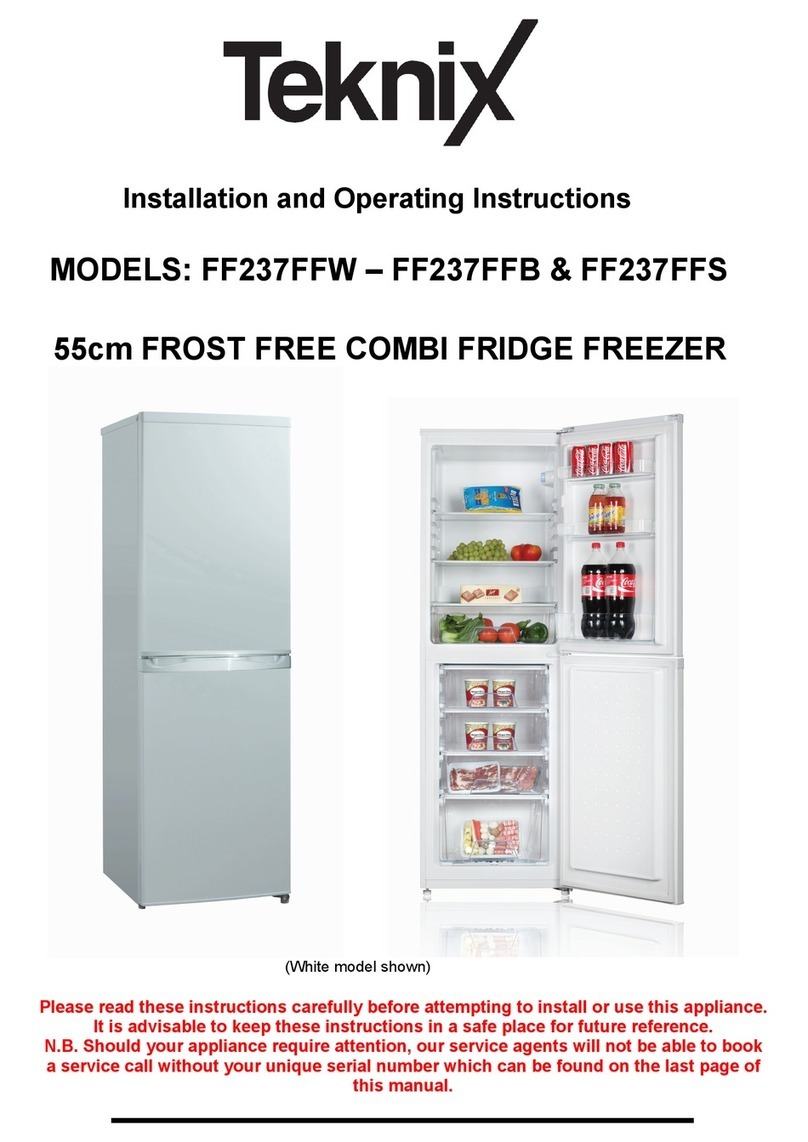
TEKNIX
TEKNIX FF237FFW User manual
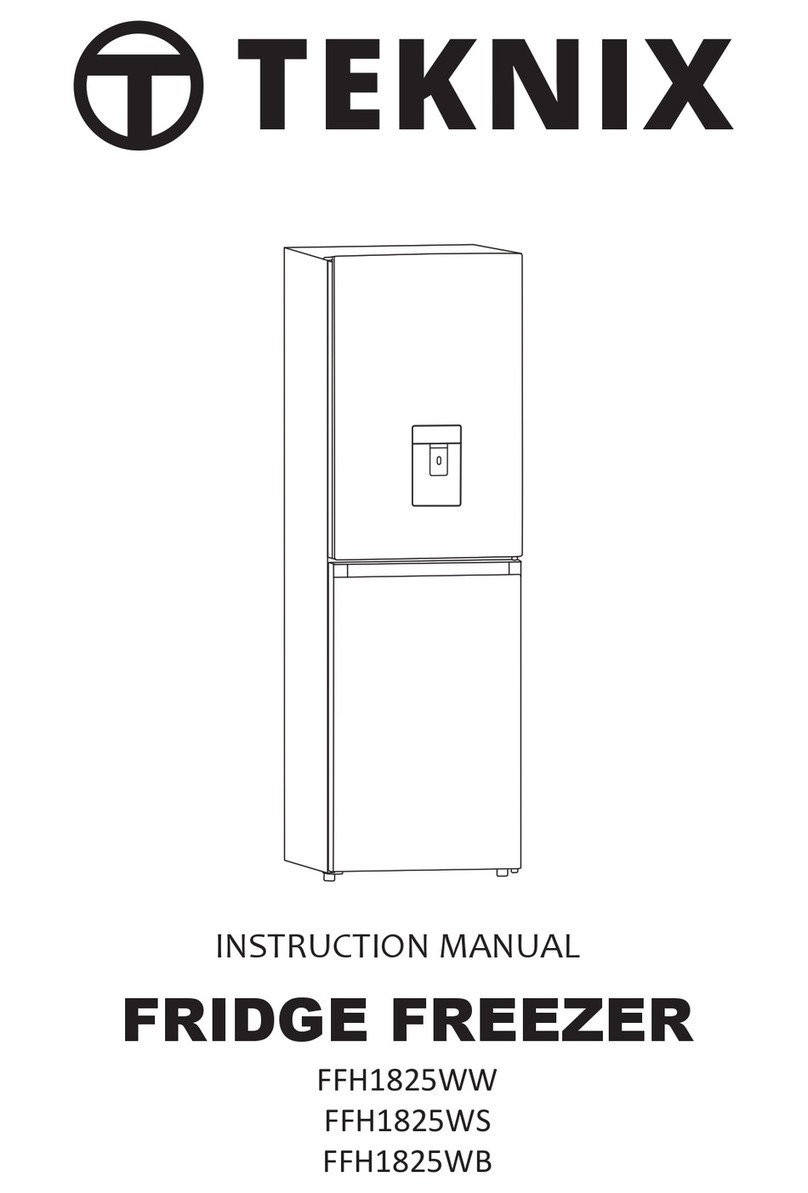
TEKNIX
TEKNIX FFH1825WW User manual

TEKNIX
TEKNIX THSBS17784X User manual
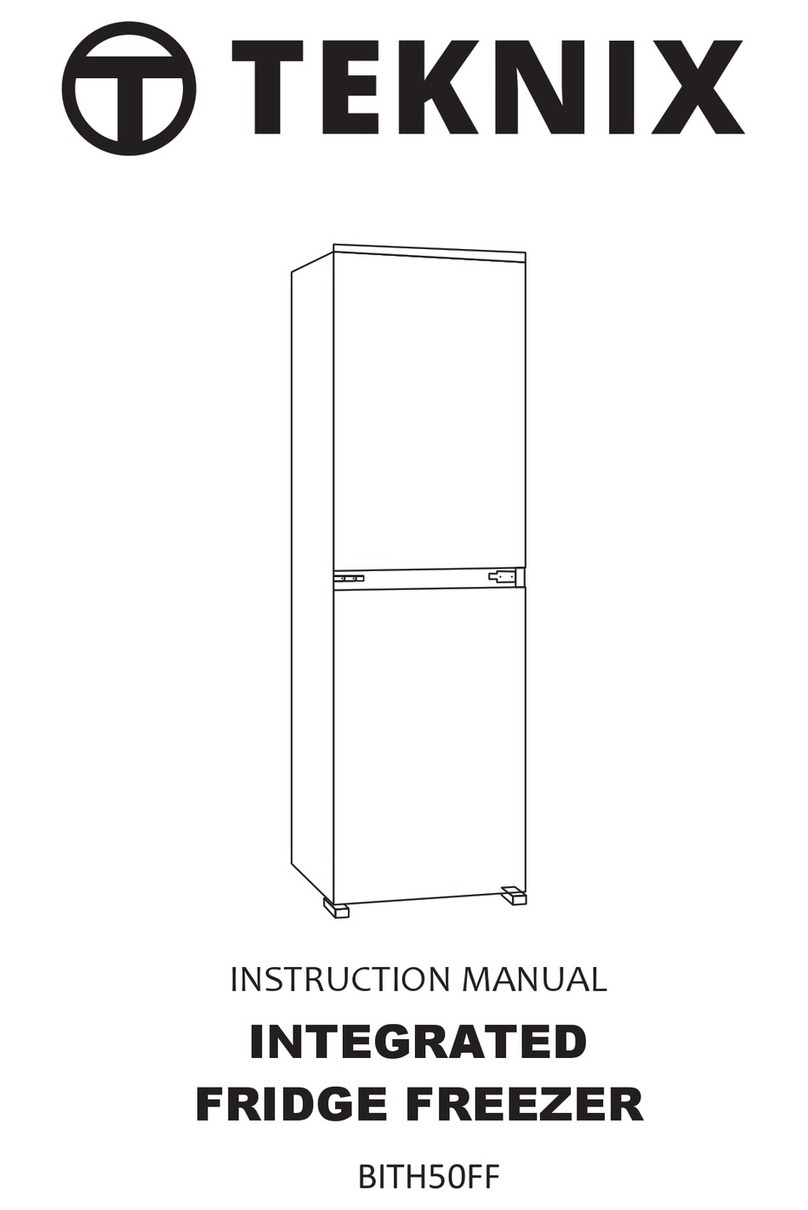
TEKNIX
TEKNIX BITH50FF User manual
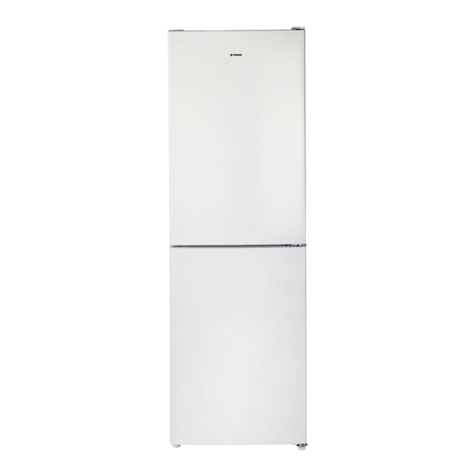
TEKNIX
TEKNIX FF1860W User manual
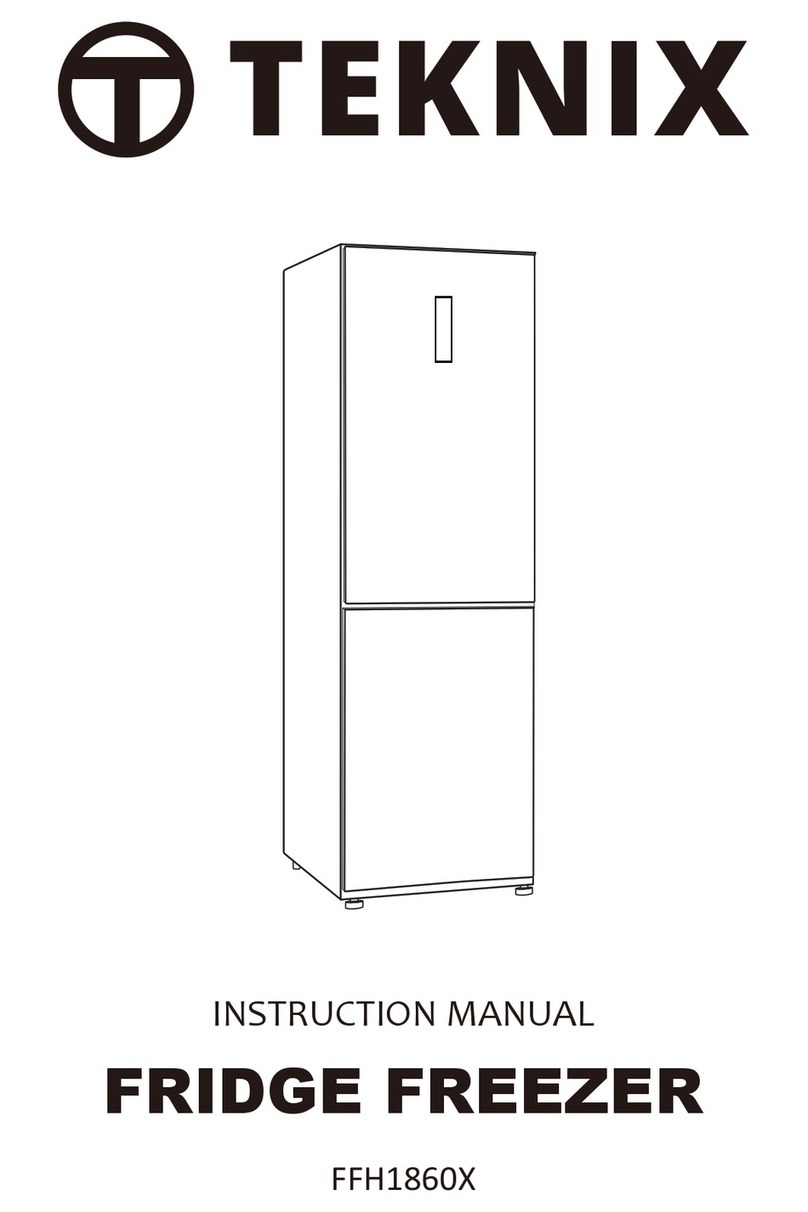
TEKNIX
TEKNIX FFH1860X User manual
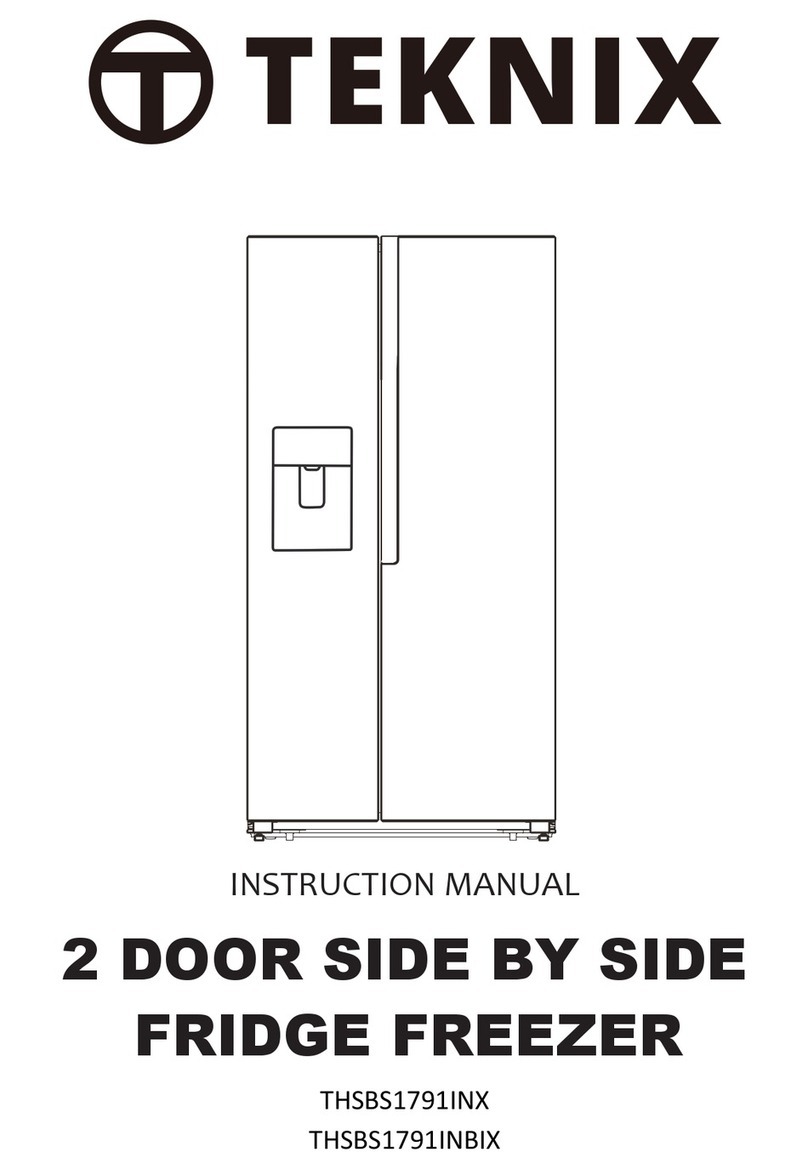
TEKNIX
TEKNIX THSBS1791INX User manual
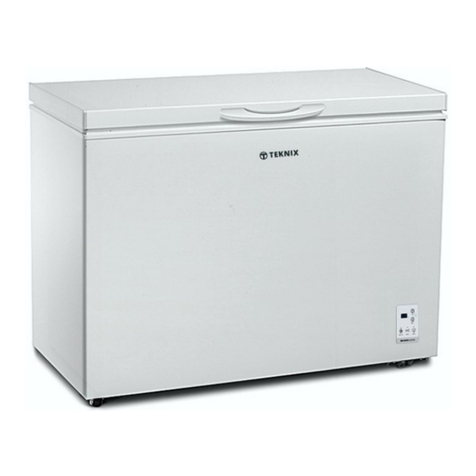
TEKNIX
TEKNIX CF102W User manual
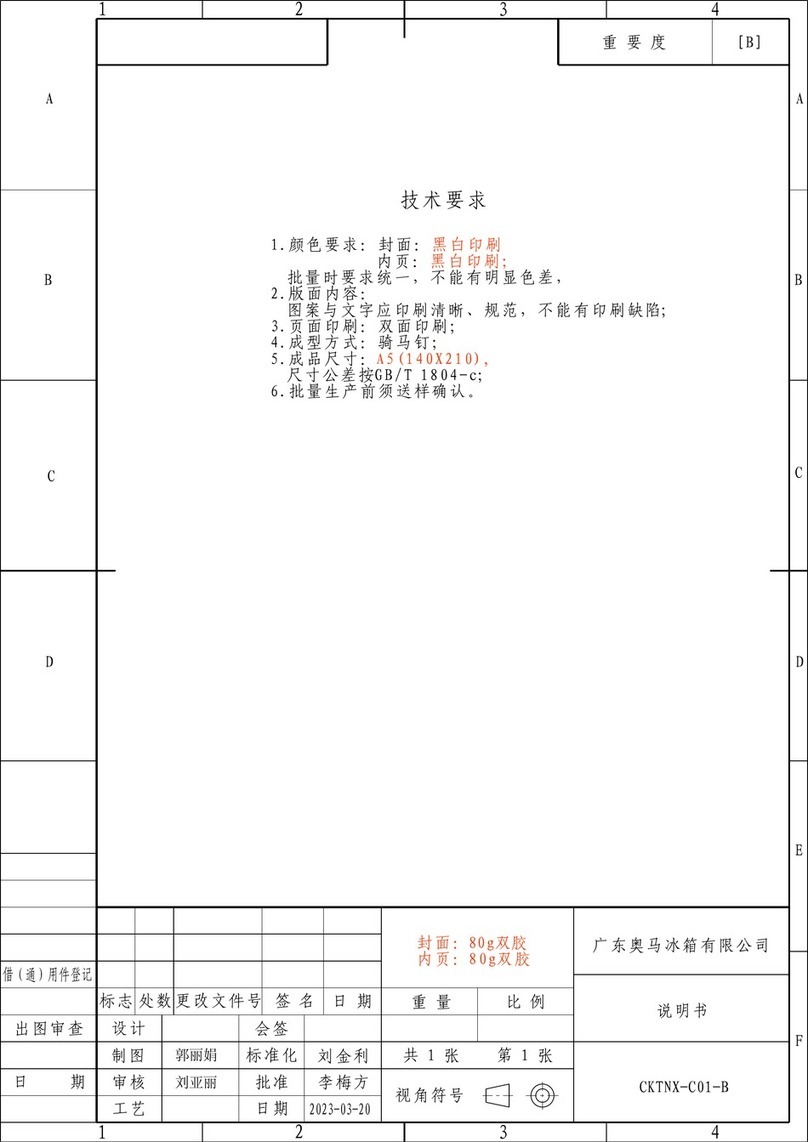
TEKNIX
TEKNIX T60FNF2W User manual
